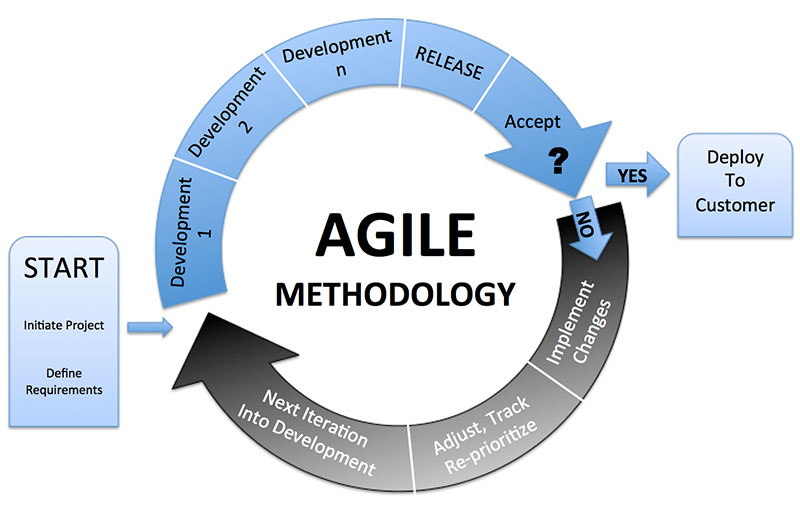How To Create a Process For Your Development Team to Follow

The success of a project doesn’t come by chance. The quality of a product is a reflection of the work process. A good end product comes from an efficient work process.
A work process that delivers good results is carefully planned and designed. It’s the synchronized effort of a group that communicates and cooperates smoothly. Think about your favorite sports team. Its success is likely due to the combination of good players and a great strategy.
You may find the best of the best to form your software development team. But without the right work strategies, the team will become stressed and frustrated, yielding poor results.
This article created by our team at TMS suggests some tips on how to create a process for your development team to follow.
How to create a process that works
A work process can be defined as “a set of steps that leads the team towards its goals, namely efficiency, effectiveness, and satisfaction.” (Encyclopedia of Human Resources Information Systems: Challenges in e-HRM by D. Shwarts-Asher, N. Ahituv, and D. Etzion)
Clear goals are essential for a clear journey. Every team member needs to be aware of the group goals and how they contribute to them. They need to know the various stages of the project, the deadlines, and their role.
The plan should lead to effectiveness and satisfaction. As noted in the definition, a set of steps will ensure the work process takes place in an organized manner. Every project is unique, but the principles of an efficient work process can be used over and over again. The team may change, but the process will remain.
Start by meeting with the team and deciding on an effective strategy. Everyone must know the objectives and the process. They can then commit to playing their part in the success of the project.
The first step

The work process definition pointed out the need for “a set of steps”. The first step happens to be the most important.
Anyone would agree that before setting off on a journey, it’s a good idea to have a map. A new project can be exciting, but a bad start can lead to a disaster. So it’s important to begin with a good plan.
Discuss where you’re going and how you’re going to get there. Everyone should know what resources are available to them. Outline and define how they’re going to collaborate as a team.
Being aware of what’s expected and the importance of their role gives each team member a clear focus. They can then set their mind on working towards the group goal. Knowing who to turn to for assistance guarantees smooth cooperation within the group.
This can happen but it’s never too late to go back to the drawing board. In fact, it’s essential if you want to avoid running into roadblocks again and again!
If the current process is not working smoothly, don’t wait too long to fix it. Think again about the definition of a work process. If the established “set of steps” is leading to frustration rather than efficiency and satisfaction, it’s time to act.
Start by identifying what part of the current process is not working. Talk to the developers. Get a clear understanding of what they need and why they are not getting it. Based on this information, change those parts of the process which are inefficient.
An in-depth and honest assessment of your strategy may be time-consuming, but the end result is worth it.
Allocating roles
“[A] team is a group of people who are interdependent with respect to information, resources, knowledge and skills and who seek to combine their efforts to achieve a common goal.” (Professor Leigh Thompson of the Kellogg School of Management)
A team is not a group of people working together. It’s a collective of individuals who combine their effort. They each need to have an allocated role in the process. It’s the integration of their unique contribution that makes it real teamwork.
Right from the start, individuals must understand what their responsibilities and tasks are. A skilled project manager should oversee the organization and collaboration among the developers. They need to identify the strengths and weaknesses of the team. The manager also ensures that the group is sharing information and communicating well.
Keeping everyone informed

Once you have put the team together and assigned roles, the project is ready to roll out. In order to ensure a clear sense of direction, keep the group informed. Having access to the project documentation keeps the team up-to-date with the progress made.
Following the development of the project will keep teams motivated and on track. Everyone likes to see what they have achieved and the status of individual tasks. A clear picture of the completion of tasks can help to identify the weak points of the chain and to fix them. You can also foresee possible delays and setbacks which may put extra pressure on some members of the group.
Project management software helps to track individual tasks and the progress of the work. Everyone in the team can see how their completed job moves to the next stage. It’s a great tool to help you stay organized and keep control of the planning, the deadlines, and the progress. There are a variety of software options available. Some software can even help with budget management and communication.
We can help you turn your idea into reality, take over your existing project, or extend your current development team.
Schedule a free consultation at hello@tms-outsource.com, or fill out the form and we will follow up with you shortly.
The right process for your software development
Moving on to the next step, it’s important to choose the right strategy. In software development, there are various approaches and work processes. These are called SDLC (Software Development Life Cycle) models.
The Waterfall Model

This model promotes a gradual execution of each stage of the project. Every phase is finished one at a time, like a cascade.
A waterfall flows in one direction. According to B. Unhelkar, this model also proceeds in a single direction. There’s little possibility to go back a phase if you need to improve or correct something.
The advantage of this model is its clarity and simplicity. It works well with smaller projects, moving phase to phase without alterations.
The Agile Approach

This model divides a project into smaller iterations. This makes it easier to apply changes and corrections. Based on client feedback, the implementation of new requirements is quickly accomplished.
This is a dynamic model, but it comes with some disadvantages too. It may be hard to determine the final cost of the project.
Always moving forward
Once you’ve got the project rolling, it’s important to keep it progressing. If workflow problems occur, stop and think – but not alone. Get the team involved!
Identifying the roadblocks is in the interest of the entire group. After all, they are all interested in the success of the project. Setbacks, delays in meeting deadlines, and accumulating workload can be discouraging.
Regular team meetings and status updates will likely clarify the matter. Good communication can reveal what part of the process needs tweaking and what’s preventing it from moving forward.
Outline again the steps leading towards the goal and reflect on the current project status. This will help to pinpoint the bottlenecks. A regular review of the priority tasks and deadlines will ensure that everyone is moving in the same direction.
Accelerating the process
Are there any other tips that can prevent the slowing down of the software development?
- Avoid multitasking. Having the team working on too many tasks at the same time is counterproductive. Make sure to limit the amount of work in progress.
- Limit the size of the workgroup. If you need a large team, divide it into smaller units. This will enhance communication and collaboration within the individual groups. They’ll be completing their tasks faster. “Agile methodology combined with many small components/micro-services and team organization around them leads to small, highly productive teams.” (Venkat Rangan, Clari Inc.)
- Find the right tools. Look for an automation software that will help you with your tasks.
- Help your developers to improve their skills. Having more professional team members leads to fewer errors and more efficient work results.
- Define the scope right at the start. “Often, the initial plan isn’t ultimately what gets done for a given project, so we take the time to ensure that we clearly understand the problem and outline what success means before we start.” (Marc Jensen, Space150)
- Run enough bugs and security tests. Detecting a problem early will save you time in the future stages of the project.
- Use SCM systems. Source control will help you to track and manage changes to code.
Ending thoughts on how to create a process for your development team
The success at the end of the project starts right at the very beginning of the job. The initial planning will affect the entire process.
Once you have given the project a good start, make sure to maintain a good pace throughout. Encourage good communication, keeping everyone informed of the progress at regular team meetings.
Evaluate priority tasks, upcoming deadlines, and workflow regularly. Be quick to identify the weak parts of the chain and make the necessary changes. Give your team the best strategy that will lead to efficiency and satisfaction.
Looking for a development partner?
If you’re looking for a technology partner, development team augmentation, or just a company for your software&app development initiatives, consider TMS.
TMS is a software and digital company in Belgrade, Serbia. We develop innovative and modern software.
A few examples include premium booking software Trafft, MedTech apps like MR Prepare, or MarTech/AdTech apps like the Advise Media Suite, among other great software examples.
Check out our services and also some of the work we’ve done for our clients. Who knows, maybe we’ll form a successful relationship.
Schedule a free consultation at hello@tms-outsource.com, or fill out the form and we will follow up with you shortly.
If you enjoyed reading this article on how to create a process, you should check out this one about web development team workflow.
We also wrote about a few related subjects like web development team structure, team as a service and dedicated development team.

